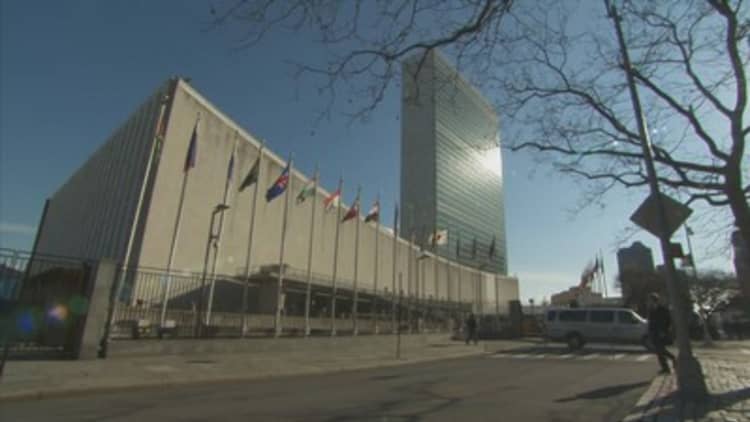
Of the millions of Syrians displaced by civil war, the United Nations estimates that more than 630,000 reside in Jordan, a small country with a population about the size of New York City.
But despite the crowds of people entering Jordan, there is no backlog of refugees waiting to be registered — thanks in part to a technology, portable iris-scanners — that looks like it belongs in "Men in Black" or "Minority Report."
Iris-scanning technology has changed how the U.N. has distributed $120 million in aid to almost 2 million refugees across the Middle East, according to Andrew Harper of the United Nations High Commissioner for Refugees (UNHCR).
"Refugees don't have to come to us, they can just go to a bank fitted with iris scanning, so we've not had to deploy any staff for procurement, transportation or warehousing," Harper said. "We are able to give refugees the money at the time of their choosing and they can use it for the reasons they believe they are most important. It reinforces the dignity of the refugee, and human dignity is the basis of almost everything we do. We have more money to help people that are most in need."
The deployment of the technology began after the UNHCR saw how the technology was already being used in banks, ATMs and airports across the Middle East. Once a bank or government agency went through the initial vetting of a person's documentation, his or her iris was scanned using non-invasive technology that is more precise than fingerprint readers. ATMs and airports then used the database to verify identities, without the need for passports or bank cards to slow down the line.
Since the pilot in 2013, Harper estimates the overhead for the refugee program has shrunk from almost 20 percent to around 2 percent.
In addition to integrating refugees into the normal banking system and reaching the more than 80 percent of refugees that live outside of camps, iris scanning has helped the U.N. deal with challenges like fraud, cybersecurity, privacy and family services, Harper said.
For instance, the iris scans can follow migrants from one camp to another — especially important for the more than 50 percent of refugees that are children and cannot be accurately fingerprinted. The scans also prevent members of extremist groups from misrepresenting themselves, and prevent the cards containing aid money from being stolen and resold.
After iris scanning was introduced for Iraqi refugees, the number of refugees requesting aid dropped 30 percent there — a result Harper attributes to fraud reduction.
"What can happen if you use vouchers or PIN numbers or ATM cards, you can have somebody to go back to Syria and sell the PIN code and sell it for a proportion of its value," Harper said. "That has significant consequences: It means we are paying people who don't deserve it when we could use it for someone else."
Harper also sees the service expanding to help refugees quickly gain access to services at hospitals. Joe O'Carroll, senior vice president of Jordan and U.K.-based biometric company IrisGuard — who created the technology — has even bigger plans to expand to the U.S. and Europe.
"Your identity is really important. ... If you know who you're dealing with, you can provide so many services," O'Carroll said. "A camera could be in a kiosk in the grocery store to renew your passport, deliver pensions and social services like [food stamps]."
O'Carroll declined to say how much the U.N. pays for iris-scanning services, noting that the price of complete system of data bases, scanners and training and support is quoted based on the size of an organization.
Though there might be advantages to the technology, it could have a dark side, too. Jonathan Shannon, a professor and cultural anthropologist at Hunter College in New York City and author of A Wintry Day in Damascus, said he is "deeply skeptical," since biometric scanning pushes the fine line between identification and surveillance.
"My main concerns regarding the use of this or any biometric identification of Syrian refugees is that the technology is merely a backdoor for attempting to monitor and control majority Muslim populations and tracking them in Europe," Shannon told CNBC in an email. "It's not likely to prevent so-called terrorists or potential terrorists from entering Europe anyway, since a retinal scan has no way of differentiating one person's intentions from another's. ... Any time government security concerns intersect with the profit motive, we have a recipe for a humanitarian disaster."




